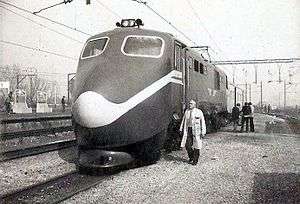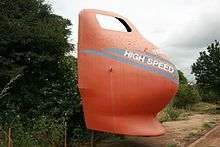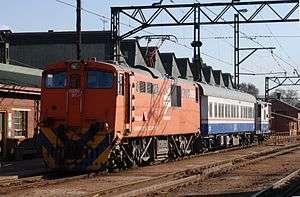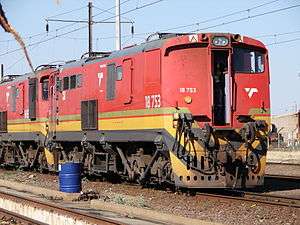South African Class 6E1, Series 4
|
No. E1481 at Beaufort West, 16 September 2009 | |||||||||||||||||||||||||||||||||||||||||||||||||||||||||
| |||||||||||||||||||||||||||||||||||||||||||||||||||||||||
| |||||||||||||||||||||||||||||||||||||||||||||||||||||||||
| |||||||||||||||||||||||||||||||||||||||||||||||||||||||||
| |||||||||||||||||||||||||||||||||||||||||||||||||||||||||
The South African Railways Class 6E1, Series 4 of 1973 was an electric locomotive.
In 1973 and 1974, the South African Railways placed one hundred Class 6E1, Series 4 electric locomotives with a Bo-Bo wheel arrangement in mainline service. One of them holds the narrow gauge world rail speed record on Cape gauge.[1][2][3]
Manufacturer
The 3 kV DC Class 6E1, Series 4 electric locomotive was designed and built for the South African Railways (SAR) by Union Carriage and Wagon (UCW) in Nigel, Transvaal, with the electrical equipment supplied by the General Electric Company (GEC).[4]
One hundred locomotives were delivered in 1973 and 1974, numbered in the range from E1446 to E1545. UCW did not allocate builder's or works numbers to the locomotives it built for the SAR and used the SAR unit numbers for their record keeping.[1]
Characteristics
Bogies


The Class 6E1 was built with sophisticated traction linkages on their bogies. Together with the locomotive's electronic wheel-slip detection system, these traction struts, mounted between the linkages on the bogies and the locomotive body and colloquially referred to as grasshopper legs, ensure the maximum transfer of power to the rails without causing wheel-slip, by reducing the adhesion of the leading bogie and increasing that of the trailing bogie by as much as 15% upon starting off. This feature is controlled by electronic wheel-slip detection devices and an electric weight transfer relay, which reduce the anchor current to the leading bogie by as much as 50A in notches 2 to 16.[2]
Brakes
The locomotive itself used air brakes, but it was equipped to operate trains with air or vacuum brakes. While hauling a vacuum braked train, the locomotive's air brake system would be disabled and the train would be controlled by using the train brakes alone to slow down and stop. While hauling an air braked train, on the other hand, the locomotive brakes would engage along with the train brakes. While working either type of train downgrade, the locomotive's regenerative braking system would also work in conjunction with the train brakes.[5]
When the locomotive was stopped, the air brakes on both bogies were applied together. The handbrake or parking brake, located in Cab no. 2, only operated on the unit's last axle, or no. 7 and 8 wheels.[5]
Orientation
These dual cab locomotives have a roof access ladder on one side only, just to the right of the cab access door. The roof access ladder end is marked as the no. 2 end. A corridor along the centre of the locomotive connects the cabs, which are identical, apart from the fact that the handbrake is located in cab 2. A pantograph hook stick is stowed in a tube, mounted below the lower edge of the locomotive body on the roof access ladder side. The locomotive has three small panels along the lower half of the body on the roof access ladder side, and only one panel on the opposite side.[1]
Series identifying features
The Class 6E1 was produced in eleven series over a period of nearly sixteen years. While some Class 6E1 series are visually indistinguishable from their predecessors or successors, some externally visible changes did occur over the years. Series 1 locomotives had their sandboxes mounted on the bogies, while Series 2 to 11 had their sandboxes mounted along the bottom edge of the locomotive body, with the sandbox lids fitting into recesses in the body.[1]
The Series 3 to Series 5 locomotives are visually indistinguishable from each other, the only externally visible difference being the narrower stirrup middle step below the side doors of the first fifty Series 3 locomotives, those in the number range from E1296 to E1345.[1][2][6][7]
Service
The Class 6E1 family saw service all over both 3 kV DC mainline and branchline networks, the smaller Cape Western network between Cape Town and Beaufort West, and the larger network which covers portions of the Northern Cape, the Free State, Natal, Gauteng, North West Province and Mpumalanga.[3]
World rail speed record

In 1978, one of the Series 4 locomotives, no. E1525, was modified for experiments in high speed traction, by re-gearing the traction motors, installing SAR-designed Scheffel bogies and fitting a streamlined nose cone on the no. 1 end. In this configuration, no. E1525 managed to reach a speed of 245 kilometres per hour (152 miles per hour) on a stretch of track between Westonaria and Midway on 31 October 1978, a still unbeaten narrow gauge world record on 3 feet 6 inches (1,067 millimetres) Cape gauge.[2][3][8]

During November 1980, the same locomotive was used to test the British Rail-Brecknell Willis single-arm high speed pantograph, then still under development, as part of the SAR's research towards introducing a new high speed MetroBlitz service between Pretoria and Johannesburg. A number of European pantographs were being evaluated for use on the Class 6E1, with the trains running at 90 miles per hour (145 kilometres per hour) under catenary which usually saw nothing above 50 miles per hour (80 kilometres per hour). Testing took place over a 10 kilometres (6.2 miles) stretch of straight track between Rosslyn and De Wildt on the line between Pretoria and Brits. During the trials, speeds of up to 125 miles per hour (201 kilometres per hour) were achieved with the pantograph.[8]

In the 2000s, similar single-arm type pantographs were adopted by Spoornet. These pantographs gradually replaced the older box-frame type pantographs on all electric locomotive types, as and when replacement became necessary. Along with Class Experimental AC no. E1600, no. E1525 is still dedicated to testing projects, since its different gear ratio and traction effort curves make it unsuitable for use in multi-unit working with other Class 6E1 locomotives in the fleet.[9]
The MetroBlitz service commenced in January 1984. This testing project eventually bore more fruit in 2011, upon the opening of the 1,435 millimetres (4 feet 8½ inches) broad gauge Gautrain which connects Pretoria, Johannesburg and the O.R. Tambo International Airport (the former Jan Smuts Airport) in Kempton Park.[8]
Reclassification and rebuilding
Reclassification to Class 16E
During 1990 and 1991, Spoornet semi-permanently coupled several pairs of otherwise largely unmodified Class 6E1 locomotives, reclassified them to Class 16E and allocated a single locomotive number to each pair, with the individual locomotives in the pairs inscribed "A" or "B". The aim was to accomplish savings on cab maintenance, by coupling the locomotives at their no. 1 ends, abandoning the no. 1 end cabs in terms of maintenance and using only the no. 2 end cabs.[3]
One known Series 4 locomotive, no. E1457, was part of such a Class 16E pair and became Class 16E no. 16-305B.[3]
Rebuilding to Class 18E

Beginning in 2000, Spoornet began a project to rebuild Series 2 to 11 Class 6E1 locomotives to Class 18E, Series 1 and Series 2 at the Transnet Rail Engineering (TRE) workshops at Koedoespoort. In the process, the cab at the no. 1 end was stripped of all controls and the driver's front and side windows were blanked off to have a toilet installed, thereby forfeiting the locomotive's bi-directional ability.[3][10]
Since the driving cab's noise level had to be below 85 decibels, cab 2 was selected as the Class 18E driving cab, primarily based on its lower noise level compared to cab 1, which is closer and more exposed to the compressor's noise and vibration. Another factor was the closer proximity of cab 2 to the low voltage switch panel. The fact that the handbrake was located in cab 2, was not a deciding factor, but was considered an additional benefit.[10]
The known Class 6E1, Series 4 locomotives which were used in this project were all rebuilt to Class 18E, Series 2 locomotives. Their numbers and renumbering details are shown in the table.[10]
Count |
6E1 no. |
Year built |
18E no. |
18E series |
Year rebuilt |
Notes |
|---|---|---|---|---|---|---|
| 1 | E1446 | 1973 | 18-785 | 2 | 2014 | circa 2014 |
| 2 | E1447 | 1973 | 18-708 | 2 | 2012 | |
| 3 | E1451 | 1973-74 | 18-855 | 2 | 2015 | |
| 4 | E1452 | 1973 | 18-421 | 2 | 2012 | PRASA |
| 5 | E1453 | 1973 | 18-742 | 2 | 2013 | |
| 6 | E1458 | 1973 | 18-657 | 2 | 2011 | |
| 7 | E1459 | 1973 | 18-429 | 2 | 2013 | PRASA |
| 8 | E1460 | 1973 | 18-425 | 2 | 2012 | PRASA |
| 9 | E1461 | 1973 | 18-829 | 2 | 2015 | |
| 10 | E1463 | 1973 | 18-658 | 2 | 2011 | |
| 11 | E1467 | 1973 | 18-433 | 2 | 2013 | PRASA |
| 12 | E1469 | 1973-74 | 18-857 | 2 | 2015 | |
| 13 | E1470 | 1973-74 | 18-671 | 2 | 2011 | |
| 14 | E1471 | 1973-74 | 18-804 | 2 | 2014 | circa 2014 |
| 15 | E1473 | 1973-74 | 18-802 | 2 | 2014 | circa 2014 |
| 16 | E1476 | 1973-74 | 18-797 | 2 | 2014 | circa 2014 |
| 17 | E1477 | 1973-74 | 18-846 | 2 | 2015 | |
| 18 | E1478 | 1973-74 | 18-848 | 2 | 2015 | |
| 19 | E1479 | 1973-74 | 18-666 | 2 | 2011 | |
| 20 | E1480 | 1973-74 | 18-660 | 2 | 2011 | |
| 21 | E1481 | 1973-74 | 18-428 | 2 | 2012 | PRASA |
| 22 | E1483 | 1973-74 | 18-856 | 2 | 2015 | |
| 23 | E1484 | 1973-74 | 18-852 | 2 | 2015 | |
| 24 | E1486 | 1973-74 | 18-854 | 2 | 2015 | |
| 25 | E1487 | 1973-74 | 18-659 | 2 | 2011 | |
| 26 | E1488 | 1973-74 | 18-765 | 2 | 2013 | |
| 27 | E1490 | 1973-74 | 18-424 | 2 | 2012 | PRASA |
| 28 | E1492 | 1973-74 | 18-719 | 2 | 2012 | |
| 29 | E1493 | 1973-74 | 18-640 | 2 | 2011 | |
| 30 | E1494 | 1974 | 18-665 | 2 | 2011 | |
| 31 | E1495 | 1974 | 18-763 | 2 | 2013 | |
| 32 | E1498 | 1974 | 18-787 | 2 | 2014 | circa 2014 |
| 33 | E1501 | 1974 | 18-696 | 2 | 2012 | |
| 34 | E1502 | 1974 | 18-675 | 2 | 2011 | |
| 35 | E1503 | 1974 | 18-669 | 2 | 2011 | |
| 36 | E1504 | 1974 | 18-847 | 2 | 2015 | |
| 37 | E1505 | 1974 | 18-840 | 2 | 2015 | |
| 38 | E1506 | 1974 | 18-831 | 2 | 2015 | |
| 39 | E1507 | 1974 | 18-838 | 2 | 2015 | |
| 40 | E1508 | 1974 | 18-638 | 2 | 2010 | |
| 41 | E1509 | 1974 | 18-841 | 2 | 2015 | |
| 42 | E1510 | 1974 | 18-845 | 2 | 2015 | |
| 43 | E1511 | 1974 | 18-784 | 2 | 2014 | circa 2014 |
| 44 | E1512 | 1974 | 18-688 | 2 | 2011 | |
| 45 | E1513 | 1974 | 18-843 | 2 | 2015 | |
| 46 | E1514 | 1974 | 18-836 | 2 | 2015 | |
| 47 | E1516 | 1974 | 18-714 | 2 | 2012 | |
| 48 | E1517 | 1974 | 18-774 | 2 | 2013 | circa 2013 |
| 49 | E1518 | 1974 | 18-738 | 2 | 2013 | |
| 50 | E1519 | 1974 | 18-650 | 2 | 2010 | |
| 51 | E1520 | 1974 | 18-853 | 2 | 2015 | |
| 52 | E1521 | 1974 | 18-643 | 2 | 2010 | |
| 53 | E1522 | 1974 | 18-839 | 2 | 2015 | |
| 54 | E1524 | 1974 | 18-674 | 2 | 2011 | |
| 55 | E1526 | 1974 | 18-740 | 2 | 2013 | |
| 56 | E1527 | 1974 | 18-758 | 2 | 2013 | |
| 57 | E1529 | 1974 | 18-833 | 2 | 2015 | |
| 58 | E1530 | 1974 | 18-656 | 2 | 2011 | |
| 59 | E1531 | 1974 | 18-718 | 2 | 2012 | |
| 60 | E1532 | 1974 | 18-739 | 2 | 2013 | |
| 61 | E1533 | 1974 | 18-767 | 2 | 2013 | |
| 62 | E1534 | 1974 | 18-834 | 2 | 2015 | |
| 63 | E1535 | 1974 | 18-636 | 2 | 2010 | |
| 64 | E1536 | 1974 | 18-717 | 2 | 2012 | |
| 65 | E1537 | 1974 | 18-753 | 2 | 2013 | |
| 66 | E1538 | 1974 | 18-694 | 2 | 2012 | |
| 67 | E1540 | 1974 | 18-746 | 2 | 2013 | |
| 68 | E1542 | 1974 | 18-780 | 2 | 2013 | circa 2013 |
| 69 | E1544 | 1974 | 18-749 | 2 | 2013 | |
| 70 | E1545 | 1974 | 18-781 | 2 | 2014 | circa 2014 |
Illustration
All the Class 6E1, Series 4 locomotives were delivered in the SAR Gulf Red and yellow whiskers livery, illustrated in the main picture of no. E1481. Illustrated below, are some of the other liveries in which Series 4 locomotives served.
- No. E1446 in Spoornet orange livery at Sentrarand Yard, Gauteng, 8 October 2009
- No. E1461 in Spoornet maroon livery at Capital Park, Pretoria, 9 May 2006
- No. E1464 in Spoornet blue livery with solid numbers at Bellville Depot, 26 April 2009
- No. E1464 in the Passenger Rail Agency of South Africa's Shosholoza Meyl livery at Bellville Depot, 26 January 2010
References
- 1 2 3 4 5 South African Railways Index and Diagrams Electric and Diesel Locomotives, 610mm and 1065mm Gauges, Ref LXD 14/1/100/20, 28 January 1975, as amended
- 1 2 3 4 Paxton, Leith; Bourne, David (1985). Locomotives of the South African Railways (1st ed.). Cape Town: Struik. pp. 128–129. ISBN 0869772112.
- 1 2 3 4 5 6 Middleton, John N. (2002). Railways of Southern Africa Locomotive Guide - 2002 (as amended by Combined Amendment List 4, January 2009) (2nd, Dec 2002 ed.). Herts, England: Beyer-Garratt Publications. pp. 56–57.
- ↑ "UCW - Electric locomotives" (PDF). The UCW Partnership. Archived from the original (PDF) on 12 October 2007. Retrieved 30 September 2010.
- 1 2 Operation - South African Classes 6E, 6E1, 16E, 17E and 18E
- ↑ E1345 with narrow stirrup
- ↑ E1346 with wide stirrup
- 1 2 3 Pantograph Testing in South Africa in 1980
- ↑ Facebook Group Suid-Afrikaaanse Spoorweë / SA Railways / Ulolwe - Comment by Philmar du Plessis: 24 May 2015 at 19:29 (Accessed 17 August 2015)
- 1 2 3 Information gathered from the rebuild files of individual locomotives at Transnet Rail Engineering's Koedoespoort shops, or obtained from John Middleton as well as several Transnet employees
External links
|
|
| Wikimedia Commons has media related to |